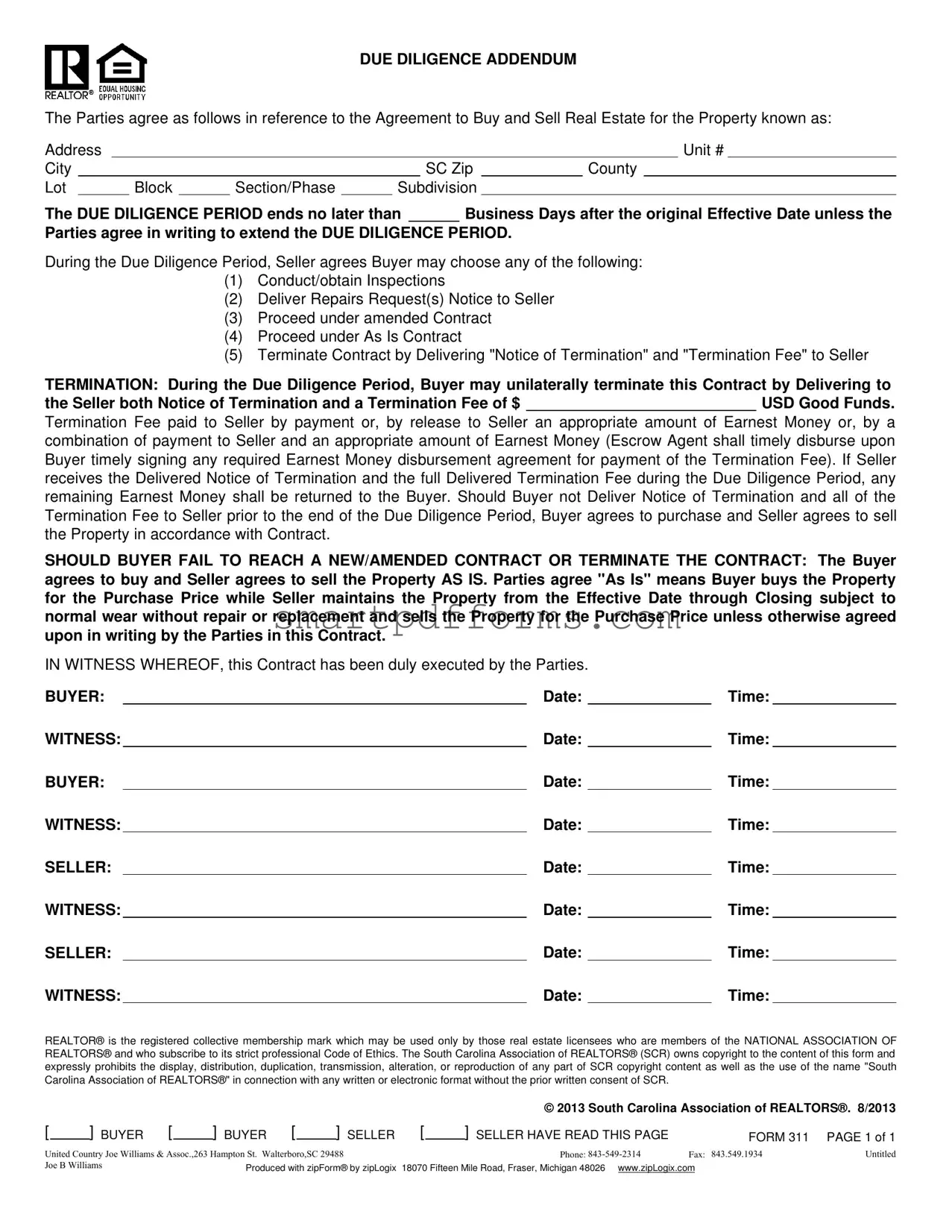DUE DILIGENCE ADDENDUM
The Parties agree as follows in reference to the Agreement to Buy and Sell Real Estate for the Property known as:
Address |
|
|
|
|
|
|
|
|
|
|
|
|
Unit # |
|
City |
|
|
|
|
|
|
|
|
SC Zip |
|
County |
|
Lot |
|
|
Block |
|
Section/Phase |
|
Subdivision |
|
|
|
|
|
The DUE DILIGENCE PERIOD ends no later than |
|
|
Business Days after the original Effective Date unless the |
Parties agree in writing to extend the DUE DILIGENCE PERIOD. |
|
|
|
|
During the Due Diligence Period, Seller agrees Buyer may choose any of the following:
(1)Conduct/obtain Inspections
(2)Deliver Repairs Request(s) Notice to Seller
(3)Proceed under amended Contract
(4)Proceed under As Is Contract
(5)Terminate Contract by Delivering "Notice of Termination" and "Termination Fee" to Seller
TERMINATION: During the Due Diligence Period, Buyer may unilaterally terminate this Contract by Delivering to
the Seller both Notice of Termination and a Termination Fee of $ |
|
USD Good Funds. |
Termination Fee paid to Seller by payment or, by release to Seller an appropriate amount of Earnest Money or, by a combination of payment to Seller and an appropriate amount of Earnest Money (Escrow Agent shall timely disburse upon Buyer timely signing any required Earnest Money disbursement agreement for payment of the Termination Fee). If Seller receives the Delivered Notice of Termination and the full Delivered Termination Fee during the Due Diligence Period, any remaining Earnest Money shall be returned to the Buyer. Should Buyer not Deliver Notice of Termination and all of the Termination Fee to Seller prior to the end of the Due Diligence Period, Buyer agrees to purchase and Seller agrees to sell the Property in accordance with Contract.
SHOULD BUYER FAIL TO REACH A NEW/AMENDED CONTRACT OR TERMINATE THE CONTRACT: The Buyer agrees to buy and Seller agrees to sell the Property AS IS. Parties agree "As Is" means Buyer buys the Property for the Purchase Price while Seller maintains the Property from the Effective Date through Closing subject to normal wear without repair or replacement and sells the Property for the Purchase Price unless otherwise agreed upon in writing by the Parties in this Contract.
IN WITNESS WHEREOF, this Contract has been duly executed by the Parties.
BUYER: |
|
Date: |
|
Time: |
WITNESS: |
|
Date: |
|
Time: |
BUYER: |
|
Date: |
|
Time: |
WITNESS: |
|
Date: |
|
Time: |
SELLER: |
|
Date: |
|
Time: |
WITNESS: |
|
Date: |
|
Time: |
SELLER: |
|
Date: |
|
Time: |
WITNESS: |
|
Date: |
|
Time: |
REALTOR® is the registered collective membership mark which may be used only by those real estate licensees who are members of the NATIONAL ASSOCIATION OF REALTORS® and who subscribe to its strict professional Code of Ethics. The South Carolina Association of REALTORS® (SCR) owns copyright to the content of this form and expressly prohibits the display, distribution, duplication, transmission, alteration, or reproduction of any part of SCR copyright content as well as the use of the name "South Carolina Association of REALTORS®" in connection with any written or electronic format without the prior written consent of SCR.
|
|
|
|
|
|
|
|
|
|
|
© 2013 South Carolina Association of REALTORS®. 8/2013 |
[ |
|
] BUYER |
[ |
|
] BUYER |
[ |
|
] SELLER |
[ |
|
] SELLER HAVE READ THIS PAGE |
FORM 311 |
PAGE 1 of 1 |
|
|
|
|
United Country Joe Williams & Assoc.,263 Hampton St. Walterboro,SC 29488 |
|
|
PHONE: 843-549-2314 |
FAX: 843.549.1934 |
Untitled |
Joe B Williams |
|
|
Produced with zipForm® by zipLogix 18070 Fifteen Mile Road, Fraser, Michigan 48026 www.zipLogix.com |
|
|
|
|
|
|
|

